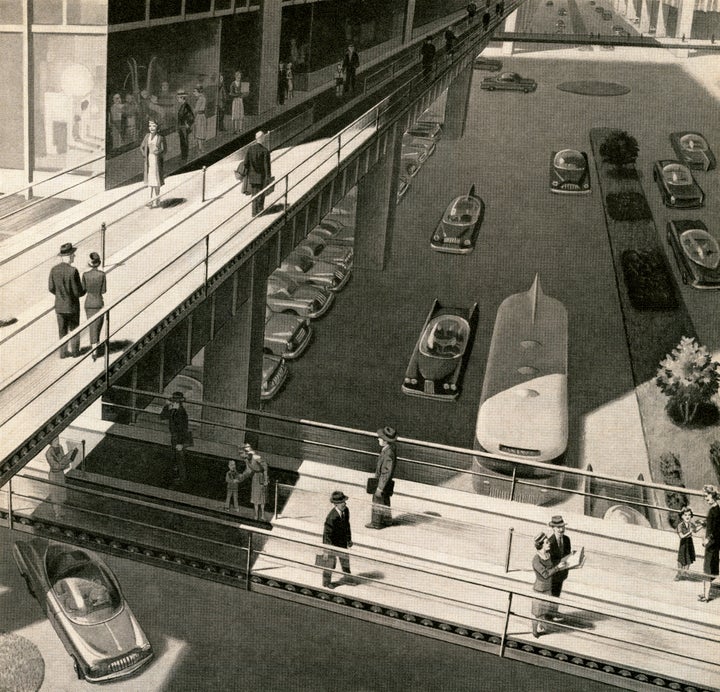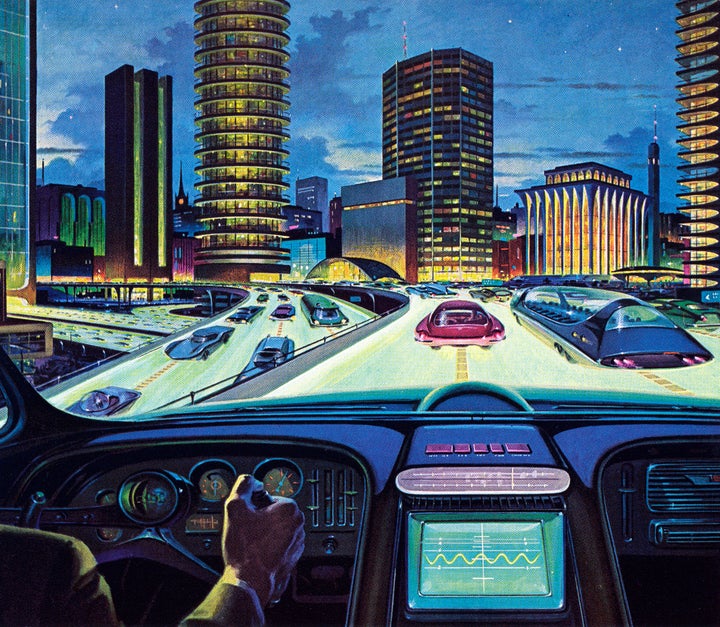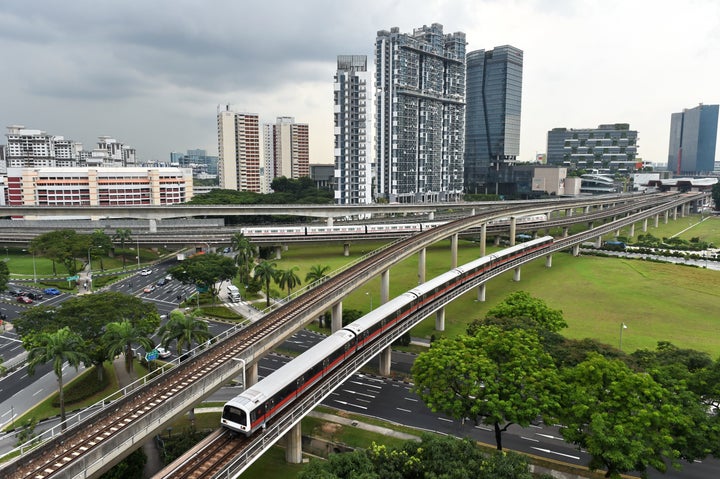
Many predictions for cities of the future have fallen spectacularly flat ― where are our moving sidewalks and zeppelins? But as technology is rapidly integrated into our lives and the built environment, considering the implications for cities in the coming decades is crucial.
The City of Tomorrow: Sensors, Networks, Hackers and the Future of Urban Life, a slim but expansive book published this summer, traces the history of technology’s impact on cities to the present and potential future, focusing on transformations in areas like transportation, architecture, labor and energy.
Authors Carlo Ratti and Matthew Claudel, who conduct research at the Massachusetts Institute of Technology Senseable City Laboratory, pointedly refuse to make specific predictions. Instead, they look at how emerging technology could change cities through a practice they call “futurecraft.”
Ratti and Claudel say they imagine hypothetical future scenarios and their consequences, and then bring those ideas to the public as a way to accelerate positive technological change ― and hopefully create a better future.
Many of the ideas in The City of Tomorrow rely on the increased data that is making cities “smarter,” or using that data to operate more efficiently. For example, technology like sensors in lighting grids and transit networks would let infrastructure respond to real-time usage. In the future, sensors, combined with sources like cell phone data, could provide an overwhelming amount of information about a city and its residents.
“Physical space could be laced ubiquitously with nanosensors ― scattered micro devices that are smaller than grains of rice,” Ratti and Claudel write about so-called “smart dust.”
“Using smartphone-integrated sensing devices, pedestrian commuters could generate data at the human scale, as though a tracer were running through the veins of the cities, showing the urban environment that commuters live in and move through,” they continue.

Pervasive data collection and tracking of citizens can also prompt visions of a dystopian future, with concerns about privacy, and how information is used and who owns it. We’ve already seen how data can be used against residents, such as landlords mining applicants’ online history or using cameras to catch tenants violating their lease.
But smarter cities can also be more equitable and sustainable ones, equipping residents with tools to understand and change their environment, Ratti and Claudel argue:
Through your smartphone, you can understand and digest the broader, complex reality of the city. It serves as a control room, revealing urban systems such as transportation, weather and social and interactive media. Understanding these urban dynamics enables people to more effectively (or enjoyably) inhabit the city.
At the Senseable City Lab, they’ve shown how some of the emerging technologies can have civic benefits: for instance, they’ve been attaching GPS trackers to everyday garbage and recyclable electronics to see how our trash moves around the country and globe, revealing new information about waste management systems that are largely invisible to citizens.
Ratti and Claudel envision a potential future where new technology ― from individualized heating grids to neighborhood 3D-printing fabrication studios ― “weaves into a tapestry of citizen empowerment.”
“The city of tomorrow is the city we build together,” the authors told The Huffington Post by email. They continued by elaborating on their thoughts about the problem with smart cities, the changing role of the car and how residents can use technology to improve their communities.

The term “smart city” gets thrown around a lot. Would you change anything about how smart cities are commonly discussed or used as a model?
The term itself, “Smart City,” is somewhat over-used, even abused. “Senseable City” is, to us, a better framework to approach urban design and science ― it brings the human side of cities to the foreground. The word senseable has a double meaning; it means “able to sense” and “sensible.” The common denominator of all of our projects is that they are focused, first and foremost, on people. Technology is an important part of our work (we are MIT after all!) but it is only an enabler of the deeper focus on urban life.
I came away from your book with the message that developing technologies could lead to cities that are more democratic, equitable and livable, but that it isn’t a certain outcome. How can we make sure technology is used for the civic good rather than at people’s expense?
Technology is always neutral ― it can be applied to many different ends, both good and bad. The crucial deciding factor is to enable and respect a public discourse about public technologies. The only way we can really determine what’s best for the city ― for all of us ― is if we arrive at a decision together.
But in order for technologies to be really understood and debated, they need to be prototyped, deployed, and broadly demonstrated. For that reason, we don’t only work academically: many of the projects in the book began as an academic or scientific concept, but were then translated into a video, a museum exhibition, or what we call an “urban demo.”
“The only way we can really determine what’s best for the city ― for all of us ― is if we arrive at a decision together.”
- Carlo Ratti and Matthew Claudel
And in some cases, the way we spark public discourse is not necessarily rosy ― with projects that reveal a dystopian future. It is only by outlining those undesirable futures that we can have an informed discussion about why we collectively reject a piece of technology, and decide how to move forward along a different path.
You write about apps that increase civic participation or allow new ways to use the city ― whether flagging potholes or sharing gas prices by location ― but those can seem like fun add-ons rather than technology that’s really transforming cities. How are these individual interventions part of a larger shift?
The larger shift is in pulling more and more citizens into the “city system.” Apps like the ones you mention create feedback loops of public participation. Here is a simple example: prior to widespread digital platforms, cities would send out crews after a storm to report all of the fallen trees, and then another team to remove and repair. Today, citizens themselves are a ubiquitous, immediate sensing system, distributed in all corners of the city. Not only is this faster, but individuals also know their neighborhoods intimately and can take action.
This began to happen, for example, after Hurricane Sandy: people organized at lightning speed, using location-based services, and supported their fellow citizens. The social fabric of the city is being more tightly knit, with digital platforms mobilizing a novel form of networked intelligence.
The book discusses how cities were previously “optimized” for cars, yet embracing their technology and integrating it into planning had long-term negative consequences for cities. What are the potential pitfalls in a new era of city optimization, and how can they be avoided?
The city of the 20th century was shaped by the car. That was pretty much a top-down endeavor ― by the time we realized some of its shortcomings, “car city” was a reality. I think that when dealing with today’s soft and networked technologies we take a different and more systemic approach ― creating a varied ecosystem and letting people play a role in shaping tomorrow’s cities.

What’s one of the ways cities are currently using new tools and technology that you find most exciting?
Mobility is rather interesting. Today, Singapore is a city with a long history of innovation in transportation solutions, from [electronic road pricing] to the sophisticated metro network. The island-state is now on the cutting edge of deploying a fleet of self-driving cars.
Self-driving vehicles promise to have a dramatic impact on urban life, because they could blur the distinction between private and public modes of transportation. “Your” car could give you a lift to work in the morning and then, rather than sitting idle in a parking lot, give a lift to someone else in your family ― or, for that matter, to anyone else in your neighborhood, social‐media community, or city.
Some recent papers by MIT show that today’s mobility demand of a city such as Singapore could be satisfied by just one‐fifth of the number of cars currently in use. Such reductions in car numbers would dramatically lower the cost of our mobility infrastructure and the embodied energy associated with building and maintaining it. Fewer cars may also mean shorter travel times, less congestion and a smaller environmental impact.

What is your favorite prediction for cities of the future?
All of the failed ones! History is speckled with an amazing lineage of what we can call paleofutures. For some reason, we have always been fascinated with city futures that did not materialize ― from Swiss architect Le Corbusier’s Plan Voisin to Fritz Lang’s urban dystopia in Metropolis. These are all important milestones that pivoted the evolution of how we collectively think about cities ― what we expect, demand, hope for and fear.
This interview was lightly edited and condensed.
_____

